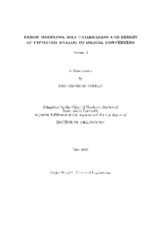| dc.contributor.advisor | Geiger, Randall L. | |
| dc.contributor.advisor | Sanchez-Sinencio, Edgar | |
| dc.creator | Soenen, Eric Georges | |
| dc.date.accessioned | 2020-09-07T18:26:28Z | |
| dc.date.available | 2020-09-07T18:26:28Z | |
| dc.date.issued | 1992 | |
| dc.identifier.uri | https://hdl.handle.net/1969.1/188924 | |
| dc.description | Typescript (photocopy). | en |
| dc.description.abstract | As the field of signal processing accelerates toward the use of high performance digital techniques, there is a growing need for increasingly fast and accurate analog to digital converters. Three highly visible examples of this trend originated in the last decade. The advent of the compact disc revolutionized the way high-fidelity audio is stored, reproduced, recorded and processed. Digital communication links, fiber optic cables and in the near future ISDN networks (Integrated Services Digital Network) are steadily replacing major portions of telephone systems. Finally, video-conferencing, multi-media computing and currently emerging high definition television (HDTV) systems rely more and more on real-time digital data compression and image enhancing techniques. All these applications rely on analog to digital conversion. In the field of digital audio, the required conversion accuracy is high, but the conversion speed limited (16 bits, 2 x 20 kHz signal bandwidth). In the field of image processing, the required accuracy is less, but the data conversion speed high (8-10 bits, 5-20MHz bandwidth). New applications keep pushing for increasing conversion rates and simultaneously higher accuracies. This dissertation discusses new analog to digital converter architectures that could accomplish this. As a consequence of the trend towards digital processing, prominent analog designers throughout the world have engaged in very active research on the topic of data conversion. Unfortunately, literature has not always kept up. At the time of this writing, it seemed rather difficult to find detailed fundamental publications about analog to digital converter design. This dissertation represents a modest attempt to remedy this situation. It is hoped that anyone with a back-ground in analog design could go through this work and pick up the fundamentals of converter operation, as well as a number of more advanced design techniques. | en |
| dc.format.extent | 2 volumes | en |
| dc.format.medium | electronic | en |
| dc.format.mimetype | application/pdf | |
| dc.language.iso | eng | |
| dc.rights | This thesis was part of a retrospective digitization project authorized by the Texas A&M University Libraries. Copyright remains vested with the author(s). It is the user's responsibility to secure permission from the copyright holder(s) for re-use of the work beyond the provision of Fair Use. | en |
| dc.rights.uri | http://rightsstatements.org/vocab/InC/1.0/ | |
| dc.subject | Major electrical engineering | en |
| dc.subject.classification | 1992 Dissertation S681 | |
| dc.subject.lcsh | Analog-to-digital converters | en |
| dc.subject.lcsh | Design | en |
| dc.subject.lcsh | Analog-to-digital converters | en |
| dc.subject.lcsh | Calibration | en |
| dc.subject.lcsh | Error-correcting codes (Information theory) | en |
| dc.title | Error modeling, self-calibration and design of pipelined analog to digital converters | en |
| dc.type | Thesis | en |
| thesis.degree.grantor | Texas A&M University | en |
| thesis.degree.name | Doctor of Philosophy | en |
| thesis.degree.name | Ph. D | en |
| dc.contributor.committeeMember | Friesen, Donald | |
| dc.contributor.committeeMember | Hester, Richard | |
| dc.contributor.committeeMember | Styblinski, M. | |
| dc.type.genre | dissertations | en |
| dc.type.material | text | en |
| dc.format.digitalOrigin | reformatted digital | en |
| dc.publisher.digital | Texas A&M University. Libraries | |
| dc.identifier.oclc | 27838178 | |



